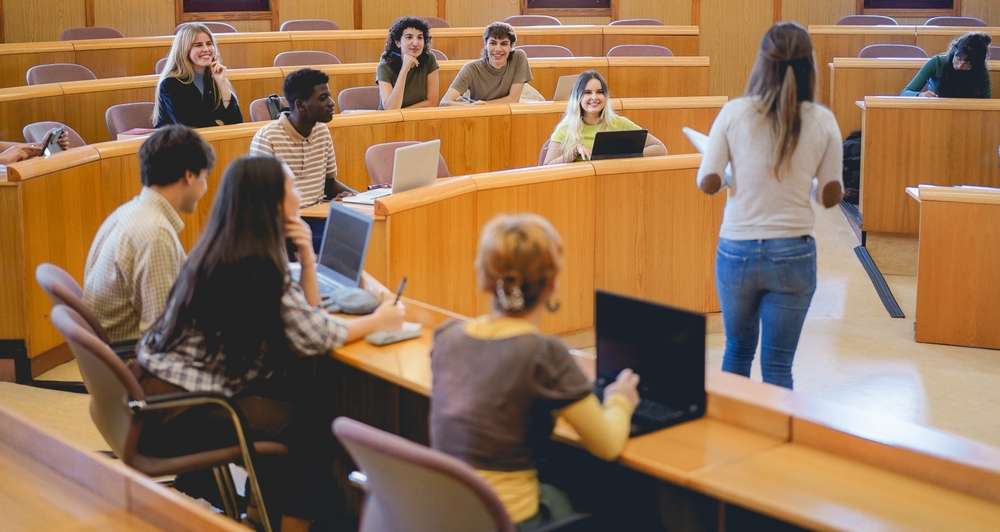
Introduction to the Intersection of Social Media and Modern Learning Communities
The rise of social media has paralleled the advancement of technology, becoming an integral part of our daily lives, namely revolutionizing the way we communicate, interact, and exchange information. It falls logically to assume that these transformations go beyond our daily personal and professional lives and permeate into the realm of education, creating what we now term ‘modern learning communities.’
Modern learning communities encompass both traditional educational institutions, like schools and universities, and more informal learning platforms, like online courses or interest-based forums. One crucial aspect of these communities is the constant interaction and collaboration between learners from diverse backgrounds. Thus, it is imperative to consider communication channels’ role within these communities, particularly social media.
In the educational sphere, social media is no longer only seen as a distractive element but as a powerful tool that can foster richer learning environments. By connecting learners worldwide, promoting interaction, and providing an inexhaustible source of information, social media plays an influential role in shaping these communities.
Platforms such as Facebook, Twitter, LinkedIn, YouTube, and Instagram, among others, offer different functionalities that have found their way into the classroom. From Facebook Groups where students can discuss coursework, Twitter hashtags for classroom activities, to YouTube channels for educational content, social media has proven to be a versatile tool. This versatility allows educators to cater to different learning styles, promote student engagement, and facilitate collaborative learning, highlighting the inherent democratic values of education.
Moreover, social media’s potential goes beyond these multifaceted uses in the classroom. It offers a platform for peer-led learning, democratizing education by making it accessible to anyone with an Internet connection. By following a hashtag on Twitter, joining a specialized Facebook group, or subscribing to a YouTube channel about a specific subject, learners can access a range of different perspectives and broaden their learning experience beyond conventional classroom walls.
However, like any powerful tool, the use of social media in education connotes a set of challenges and considerations. Ensuring all learners can access these platforms, providing necessary digital literacy training, and mitigating potential distractions or inappropriate use are among the issues that educators and administrators need to manage.
In the subsequent chapters, we will delve deeper into how specific social media platforms are utilized within educational contexts, discussing their positive impacts on student engagement and participation. We will also analyze social media as an educational tool, including its transformative potential and incumbent challenges. Our journey through the influential role of social media in modern learning communities will conclude by looking ahead, pondering the future of this dynamic intersection amidst rapid technological advancements.

Overview of Major Social Media Platforms and their Learning Communities
Digital communication has transcended beyond simple chatting and content sharing. Various platforms have evolved, creating dynamic learning communities, forming an integral part of the modern learning ecosystem. Four major social media platforms that stand out in this respect are Facebook, Twitter, LinkedIn, and YouTube.
Facebook, with over 2.8 billion monthly active users, is undoubtedly the largest social media platform globally. It offers immense potential for educators and learners through Facebook Groups. These group spaces provide learners from across the globe a place to connect, discuss, and share resources on a wide array of topics. Whether a group is based on a specific subject such as mathematics or learning English, or it’s a group dedicated to a specific course or university, it serves as a forum for collaboration and interaction. Facebook also offers features like Facebook Live, enabling real-time engagement and interaction.
Twitter is referred to as a microblogging platform, where information is passed along in bite-sized posts called tweets. With education-focused hashtags such as #EdChat, learners and educators can engage in worldwide discussions on various education-related topics. Also, Twitter Chats enable real-time group conversations that bring together education enthusiasts around a predetermined topic at a scheduled time.
LinkedIn has long been known as the professional networking site, but it also hosts numerous learning communities. LinkedIn Learning (formerly Lynda.com) provides multiple online courses, often useful for upskilling and professional development. Similarly, LinkedIn Groups furnish a platform for professionals and learners to share industry insights and discuss career-related topics.
YouTube’s global reach and accessibility make it a potent tool for learning. Its video format caters to visual learners, providing teachings on complex subjects through easily digestible material. Educators create content-rich channels which host series of videos structured as online courses. Users can leave comments, asking questions or engaging in discussions, fostering a community of learners.
Not only do these platforms provide avenues for learning, but they also promote a culture of knowledge sharing where learners turn into contributors, passing on their insights to others in the community. Considering the vast potential and reach of these platforms, their role in shaping modern learning communities cannot be underestimated. However, it’s imperative to educate learners and facilitators on their responsible use, turning social media into a powerful tool for learning and development.

The Impact of Social Media Platforms on Student Engagement and Participation
Social media has dramatically altered the way students engage and participate in learning. Now more than ever, learners are opening their devices and accessing a world of information, instruction, collaboration, and critique right at their fingertips. While this has many implications for the social aspects of youth culture, it also holds significant influence over a student’s educational experience.
Social media platforms such as Facebook, Twitter, LinkedIn, Instagram, and Snapchat are now being used increasingly in an educational context. These platforms are utilized primarily as communication tools to foster student engagement and build online learning communities. They have been found to facilitate interaction between students and teachers in a more relaxed, semi-formal environment, breaking down the traditional hierarchical barriers that sometimes exist within classrooms.
For instance, Twitter’s microblogging facility has been effectively used to promote class discussions and post assignments and readings. Students can follow threads of discussion outside of class hours, contributing their thoughts and opinions in real time. Similarly, Facebook creates an opportunity for the creation of groups where students can share course materials, discuss projects or assignments, and collaborate during study sessions.
In addition, the use of these platforms encourages students to develop and articulate their ideas publicly. This ability, to discuss, argue, and refine viewpoints based on shared content, promotes an active learning culture. It also allows students to develop digital literacy skills, such as the ability to validate online sources and succinctly deliver thoughts in a limited character space, which are increasingly important in our digital era.
Furthermore, social media platforms offer avenues for student-led learning. Young people are inherently more likely to engage with social media, which allows educators to harness this interest and enthusiasm and apply it to learning scenarios. Platforms such as these provide an array of available resources for students to explore and investigate, giving the power of learning and discovery into the hands of the students.
However, it’s important to note that while engagement and participation may be pushed into overdrive with the incorporation of social media, the emphasis should remain on controlled, valuable interaction. Social media should be viewed as but one tool in the educational tool chest, providing just one of many ways to engage and excite students in their learning.
A well-managed integration of social media into educational pedagogy can therefore promote student engagement and participation, diversifying the learning experience and ensuring that learners are equipped with the digital skills they need for the future. It provides a platform to share thoughts, widen perspectives, streamline communication, and creates a sense of learning community that goes beyond the physical boundaries of the classroom.

Analysis of Social Media as an Educational Tool
The analysis of social media as an educational tool exhibits a myriad of potential benefits that can significantly enhance the modern educational landscape. While one must carefully navigate the potential risks and consequences associated with certain aspects of social media, when appropriately applied, these platforms offer notable advantages that can transcend conventional learning methodologies.
Primarily, social media showcases its greatest strength as an educational tool through its undeniable potential for connectivity. Accessibility borders have been blurred significantly with the rise of these platforms, allowing individuals from every corner of the globe to share, interact, and learn from one another in real-time. Even in the face of unprecedented events such as global pandemics, social media has proven instrumental in ensuring learning doesn’t halt. Instant connectivity empowers remote teaching and learning, making education consistently accessible regardless of physical barriers.
Furthermore, social media can vastly broaden learners’ perspectives by enabling them to access diverse user-generated content. This variety spurs creativity and lateral thinking, encouraging learners to question, explore, and learn both independently and collaboratively. Innovative educational tools like crowdsourcing, blogging, and shared digital project workspaces all have roots grounded in social media.
Moreover, the democratic nature of social media responses to the modern learner’s intrinsic need for personalization in education. Most platforms offer filters that allow users to customize the kind of content they see, which permits learners to focus on content relevant to their needs and interests. The promotion of self-directed learning allows for greater learner autonomy, thereby fostering motivation, engagement, and lifelong learning.
Complementing traditional instructive resources, social media also supports an array of multimedia learning content, accommodating diversified learning styles. For visual learners, platforms like Instagram, Pinterest, or YouTube can offer abundant resources with extensive graphics or video content. For textual and auditory learners, platforms such as Twitter or podcasts provide beneficial outlets.
However, the use of social media in education isn’t all roses. With its benefits, come accompanying challenges which call for a need for educators and learners to navigate these spaces critically. Concerns over credibility of information, digital distraction, privacy, and online misconduct are valid and require educational strategies to manage.
Educational institutions should emphasize digital literacy as a core competency, teaching students not just how to consume content but how to analyze its relevance and credibility discerningly. In parallel, educators should establish clear guidelines on the ethical use of social media, addressing topics like cyberbullying, data privacy, and online decorum to ensure a safe and respectful digital learning environment.
In conclusion, when handled with informed, responsible digital citizenship, social media emerges as a constructively disruptive educational tool, cracking open traditional educational norms and carving a path for a more inclusive, accessible, and engaging learning experience.

Potential Challenges and Constraints of Introducing Social Media into Learning Communities
While introducing social media into learning communities has its numerous benefits, educators and parents need to be well-informed of the potential challenges and constraints that can accompany this integration.
One of the prominent challenges is the issue of distraction. In a society where attention spans are increasingly limited, the allure of social networks, with their constant updates and notifications, can draw students away from their academic tasks. For many users, social media’s constant updates and infinite scroll designs can lead to procrastination and decreased productivity.
Another significant concern is the issue of privacy. As digital spaces where personal information is usually shared, social media platforms might expose students to risks around data security and privacy. In this context, understanding how to manage digital footprints and maintain privacy becomes an essential skill, often requiring extra teaching and guidance from educators.
Furthermore, the use of social media in learning communities may exacerbate the digital divide. While many children have easy access to the Internet and digital devices, not all do. Students who lack this access may be excluded from participatory learning opportunities, thus widening educational and social gaps.
Additionally, there is a risk associated with imbalances in students’ digital skills. Students come to class with varying proficiency levels in using these tools, which can lead to discrepant learning experiences. Not every student is “digital-native”, and not every student adapts quickly to new technologies. This might require teachers to spend extra time to help some students catch up.
In some instances, social media can facilitate cyberbullying, causing emotional distress to students. The platform’s anonymity can sometimes foster a climate of hostility and negativity and can promote harmful behavior. Schools will need to have stringent cyberbullying policies in place to address these issues.
Misinformation and fake news are other potential challenges. Social media platforms are often saturated with unverified information, which can mislead students and skew their understanding of vital subjects if not correctly guided.
Lastly, there’s the question of assessment. Traditional evaluation methods may not work well for social media-assisted learning, creating difficulties for teachers to assess student performance effectively.
The potential challenges of introducing social media into learning communities are real and substantial, but with careful planning, regulation, and supervision, they can be mitigated to foster a learning environment that is engaging, inclusive, and safe. By understanding these constraints, educators may better design their digital learning approaches to ensure that they benefit students while minimizing potential distractions and pitfalls.
Conclusion: Forecasting the Future of Social Media in Learning Communities
As we move towards an increasingly interconnected era, the influence of social media on modern learning experiences continues to grow, fostering dynamic and interactive online learning communities. With the potential to revolutionize the educational landscape, the future of social media within learning communities seems to hold ample opportunities.
Moving forward, we can anticipate a broader acceptance and incorporation of social media platforms into official curricula. As more educators come to recognize the benefits of social media, such as its capacity for broad engagement, real-time feedback, and personalized learning, these platforms will likely become integral components of the modern education system.
We may also expect a surge in the development of educational technology. Just as prevalent social media platforms like Facebook, Instagram, and Twitter have been adapted for educational usage, we can predict further technological advancements that merge social media and education. This could take the form of innovative platforms specifically geared towards fostering robust learning communities, integrating data analytics, virtual reality, and artificial intelligence for a multi-faceted, experiential learning environment.
However, this promising future also brings a significant set of challenges that need to be addressed to fully harness the potential of social media in learning communities. For instance, privacy and data security concerns must be managed effectively. How we protect students’ personal information and regulate the content to which they are exposed is crucial in ensuring a safe learning environment.
Additionally, educators need to consider the feasibility of their students’ access to these platforms. Bridging the digital divide, addressing disparities in digital literacy and accessibility, will be a necessary step towards truly inclusive learning communities.
Lastly, quality assurance is another aspect that needs careful consideration. How do we measure and ensure the quality of the educational content disseminated through these platforms? What metrics do we set for determining the success of social media in education? Developing algorithms to verify educational content’s accuracy and relevance should be on the horizon.
In conclusion, the future of social media in learning communities lies at the intersection of potential and challenges. The key to navigating this landscape is adaptability. As we adapt to the digital age’s demands, it is crucial to continually reassess and recalibrate our understanding of what constitutes a learning community. To harness social media’s full potential, we must evolve our approaches to education in tandem with these digital advancements.
The rise of social media within learning communities brings the exciting prospect of education that is increasingly collaborative, interactive, and personalized. How we navigate the challenges and harness the potential of this precipice will shape the future of education and our global learning communities.


